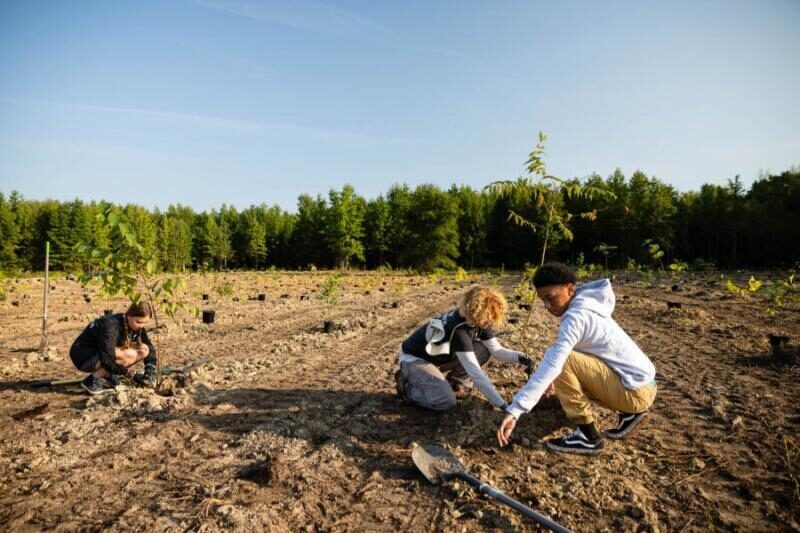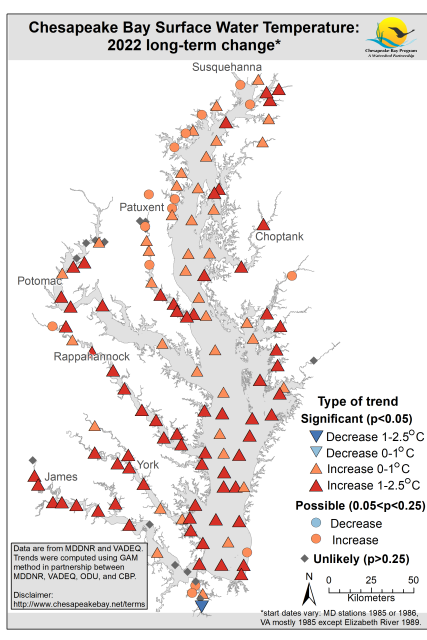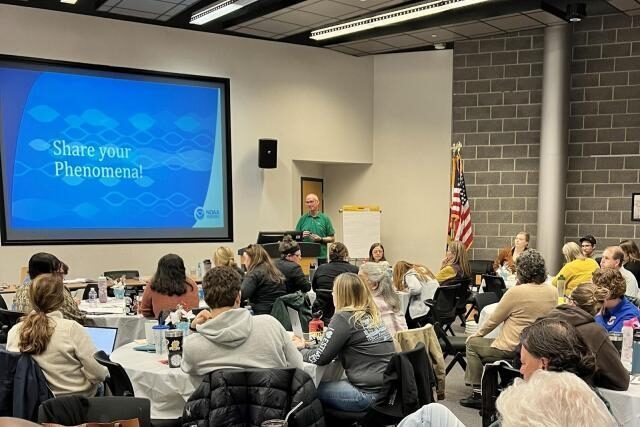Sharing Climate Change Knowledge, Inspiring Action in the Chesapeake Bay

by Kim Couranz, Communications Specialist, NOAA Chesapeake Bay Office; This blog is cross posted from NOAA Fisheries.
Climate change is already affecting the Chesapeake Bay, its watershed, and its residents—human and otherwise. Education can help people identify and work toward climate change solutions. It’s important that educators across the Chesapeake Bay watershed understand the effects of climate change. Then they can pass the most up-to-date scientific knowledge along to their students. They can also help their students—tomorrow’s watershed leaders— learn how and why to take specific actions. That’s why the NOAA Chesapeake Bay Office offers in-person workshops, online webinars and courses, and year-round opportunities to connect with other educators to support and learn from each other.
Chesapeake Bay and Climate Change
Sea Level Rise
The Chesapeake Bay can expect an additional 1.3 to 5.2 feet in sea level rise over the next century.
Increasing Temperatures
Air temperatures are rising. In 2021, the average air temperature in different parts of the Bay watershed was 0.6 to 2.8 degrees Fahrenheit higher than the 1901–2000 average.
Surface water temperatures have increased around the Chesapeake Bay. At many locations, water temperatures in 2022 were 1.8 to 4.0 degrees F higher than they were in the mid-1980s.

Precipitation
Some areas of the watershed are getting a little less precipitation, but other areas are getting much more. Compared to the 1901–2000 average, in 2021, central New York (including the headwaters of the Susquehanna River) got nearly 20 percent more precipitation.
Temperatures and precipitation in 2021 and 2022 are consistent with a long-term trend in the observational data from sites around the region.
Hosting Information-Packed Sessions
The NOAA Environmental Science Training Center offers workshops for educators to give them the information and tools they need to teach today’s students. Some workshops are in person, others are held as webinars. Often, we partner with other organizations that bring special knowledge to the sessions.
We offered several in-depth sessions focusing on climate change education this year.

Our Connecting Students to Climate Solutions was all about helping educators connect their education programs to climate solutions already in place in their states, communities and schools. This helps to make climate solutions visible. We shared examples of climate solutions happening at state, local, and school levels. Then we discussed ways educators can inspire their students to learn about, prepare for, and tackle climate change challenges.
In the Climate Resources for Supporting Meaningful Watershed Educational Experiences webinar, we offered resources to help educators develop meaningful watershed educational experiences (“MWEEs”) that focus on climate change in students’ local communities.
The Summer Institute for Climate Change Education is a 3-day climate change education conference for educators across North America held each summer. Educators who participated in the 2024 virtual workshop spent 2 days learning about climate change concepts and ways to empower their students. On the third day, they met with other educators from their region to talk about how they inspire hope and action in their communities. We partnered with Climate Generation and the NOAA Climate Program to host this event.
Online Courses for Year-Round Learning
Educators who are eager to learn how to include climate change education in their curriculum can dive into our online courses. Because teachers and informal educators have busy schedules, these courses are available 24/7. They include continuing education credits for some states in our region!
Teaching Climate Change: Climate Change Science and Storytelling
This course provides an overview of climate change topics. The topics include Earth and climate system science, climate change effects on the natural and human systems, and climate change solutions. Participants develop a story to connect climate change to their students’ lives and community.
Data Tutorial: Climate
This course features information on how educators can use data tools focused on temperature, water, and wildlife with their students. Each lesson starts with a tool tutorial. Then it highlights a story where towns or community groups have used the tool in their planning. The course shows how educators can use the tool with students to help answer a climate question.
Growing a Network for Climate Action
Many Chesapeake Bay watershed educators are excited to help their students learn about climate change and how to engage in climate action. Some are new to the field. To help them share ideas and build their skills, we and our partners established the Mid-Atlantic Climate Change Education Collaborative. The Collaborative expands upon the annual conference. It gives conference attendees and other partners the chance to work together year-round. Its action teams focus on:
- Strengthening strategic networks
- Systems-level change and advocacy
- Career and workforce development
- Youth-led climate action
- Conference planning
- K–12 programming
